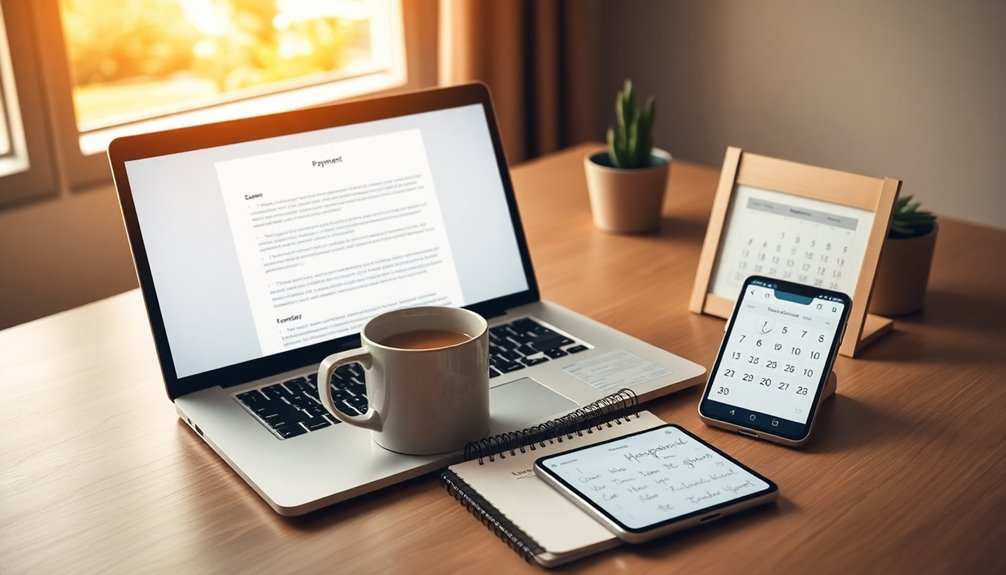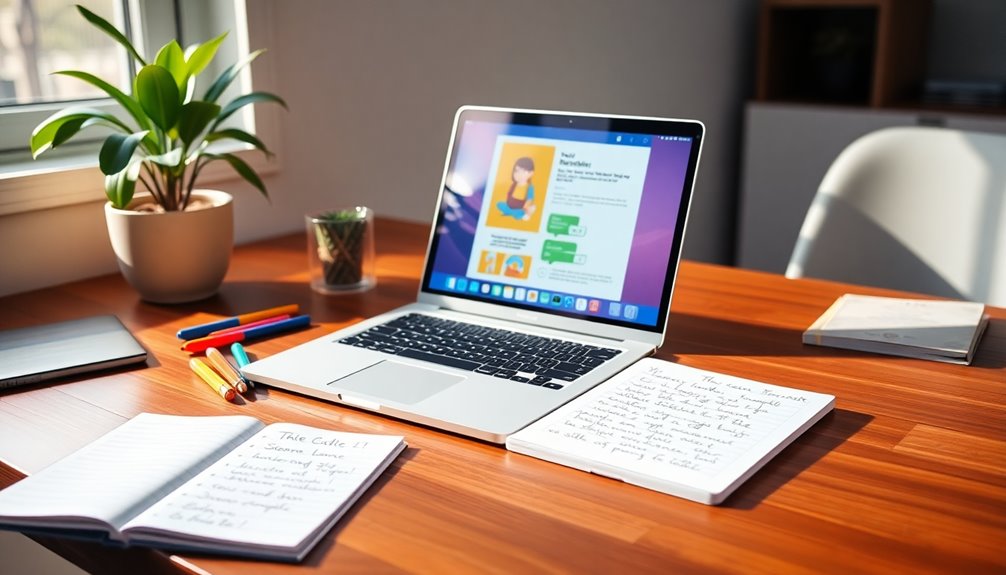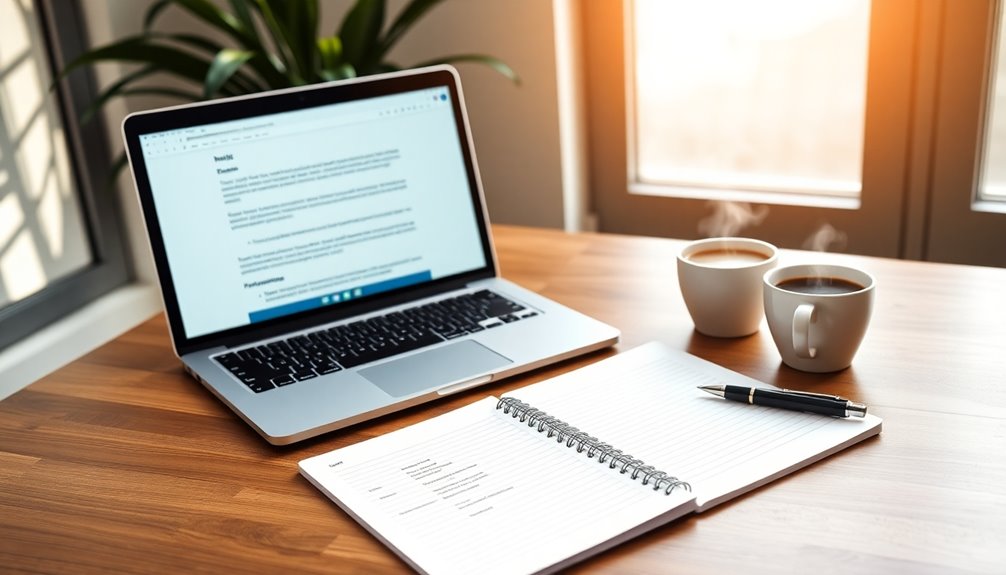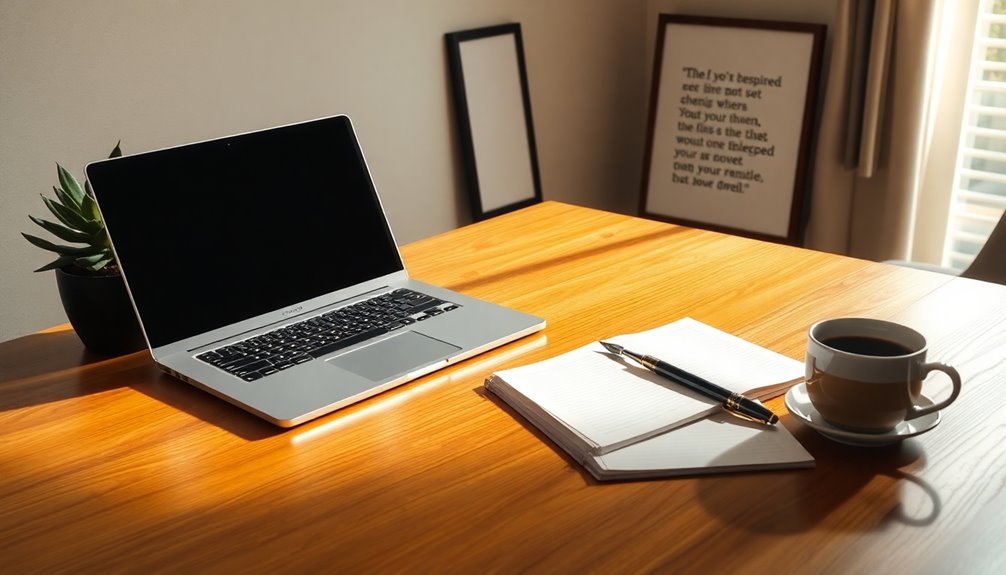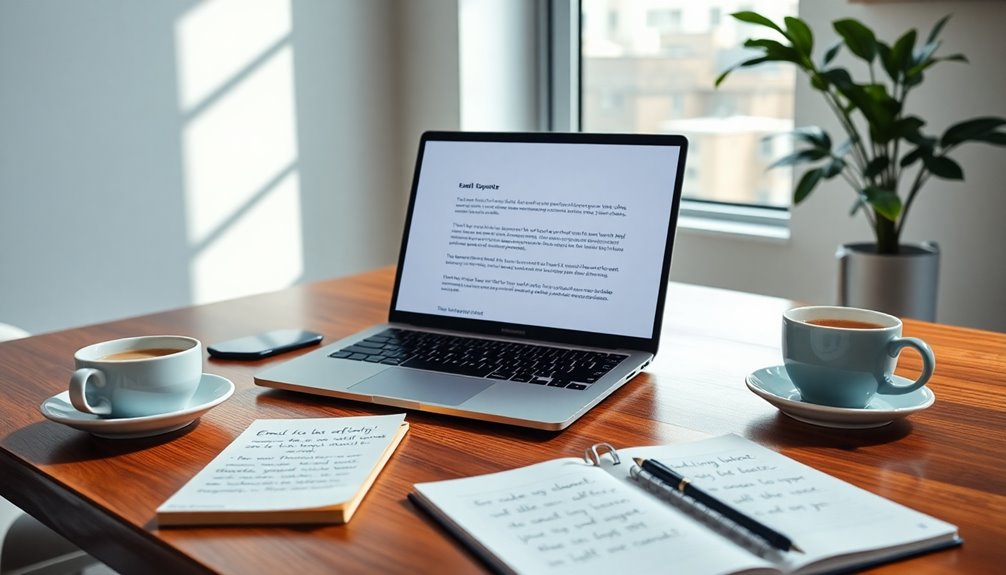To write an email that gets you paid faster, start with a clear subject line, such as "Invoice [#] Due on [Date]." Keep your tone friendly yet professional, acknowledging your client's busy schedule. In your message, include a direct payment link and multiple options for payment convenience. Attach the original invoice and clearly state the due date and total amount due. Don't forget to follow up one week before and after the due date. By building strong communication and understanding your clients, you can encourage timely payments. There's more to discover that can streamline your process.
Key Takeaways
- Use a clear subject line with the invoice number and due date to emphasize urgency and capture attention immediately.
- Personalize your message with a friendly tone, acknowledging the client's busy schedule to foster rapport.
- Include a direct payment link and offer multiple payment options to simplify the payment process for clients.
- Attach the original invoice and clearly state the due date, terms, and total amount due to avoid any misunderstandings.
- Implement a structured reminder schedule to follow up consistently, using polite language to encourage prompt payments.
Introduction
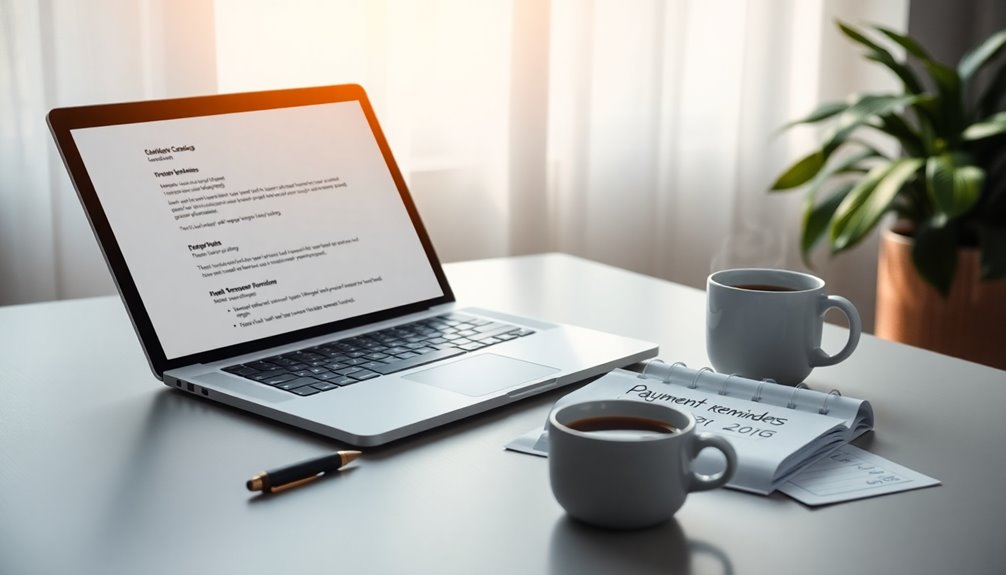
When it comes to requesting payment, getting your message across clearly and effectively can make all the difference. A well-crafted email can't only remind your client of the due invoice but also prompt them to take action.
Start with a clear subject line that includes the invoice number and due date; this makes it easy for clients to recognize the importance of your request right away.
Personalizing your email with friendly language can help acknowledge your client's busy schedule, making them more likely to respond positively. Don't forget to include a direct payment link. This simple addition can streamline the payment process and encourage prompt payment.
Setting a reminder schedule for follow-ups is crucial. Consider reaching out one week before the due date, on the due date itself, and one week afterward. This consistent communication can keep your request top of mind for your client.
Lastly, offering multiple payment options like credit card and ACH transfers increases convenience and can expedite the payment process.
Enhances Professional Relationships

A well-crafted payment request email not only prompts timely payments but also strengthens professional relationships.
When you send a polite email, you're not just addressing late payments; you're fostering a culture of clear communication. Most clients appreciate knowing that you understand their busy schedules, which helps create mutual respect and trust. Additionally, establishing consistent communication practices can further enhance your rapport with clients over time. Furthermore, maintaining clear expectations regarding payment terms can help prevent misunderstandings in future transactions. Implementing advanced fraud detection techniques can also assure clients that their payment information is secure, further building trust. Utilizing segmentation techniques can help you identify different client payment behaviors for a more tailored approach.
By clearly outlining payment terms in your emails, you set expectations and minimize confusion. A friendly reminder about upcoming due dates keeps the conversation open and reinforces your commitment to maintaining strong client relationships.
Offering convenient payment options, like online links, can significantly improve satisfaction and encourage quicker payments. Clients are more likely to respond positively when the payment process is straightforward and accessible. Additionally, incorporating advanced segmentation techniques can help tailor your payment reminders to specific client behaviors, enhancing effectiveness.
Clear Subject Line

Crafting a clear subject line is vital for grabbing your client's attention and ensuring your payment request doesn't get overlooked. Start with essential details like the invoice number and the words "Payment Request" to convey your email's purpose immediately.
For instance, using a subject line like "Invoice [#] Due on [Date]" emphasizes urgency, prompting clients to act quickly.
Don't forget to include the amount due in your subject line. A clear subject line such as "Payment Request: Invoice [#] for [$Amount]" can grab attention and remind clients of their financial obligation. This approach not only reinforces the importance of getting paid on time but also presents your request in a polite and professional manner.
Including your business name in the subject line, like "Payment Reminder for Invoice [#]," enhances recognition and establishes professionalism.
Aim to keep the subject line concise, ideally under 60 characters, ensuring it's fully visible in email previews. This simple tactic increases the likelihood of your payment request email being opened and encourages clients to pay the invoice promptly, securing the payment you need.
Step-by-Step Guide to Payment Requests

Creating an effective payment request involves several key steps that ensure your message is clear and prompts action. Start with a well-crafted subject line, like "Invoice [#] Due Soon," to grab attention immediately.
Next, attach the overdue invoice and clarify the due date and payment terms within your email. This reinforces urgency.
When you ask for payment professionally, maintain a friendly tone. Acknowledge the recipient's busy schedule while expressing appreciation for their attention to the matter.
Include a gentle payment reminder that highlights the importance of settling the invoice promptly. It's also crucial to offer multiple payment options, such as credit card or online payment links. This makes it easier for the recipient to pay quickly.
Implement a structured follow-up schedule, sending reminders one week before, on the due date, and at intervals after the invoice becomes overdue. This consistent communication keeps your request top-of-mind.
Dos and Don'ts for Payment Requests
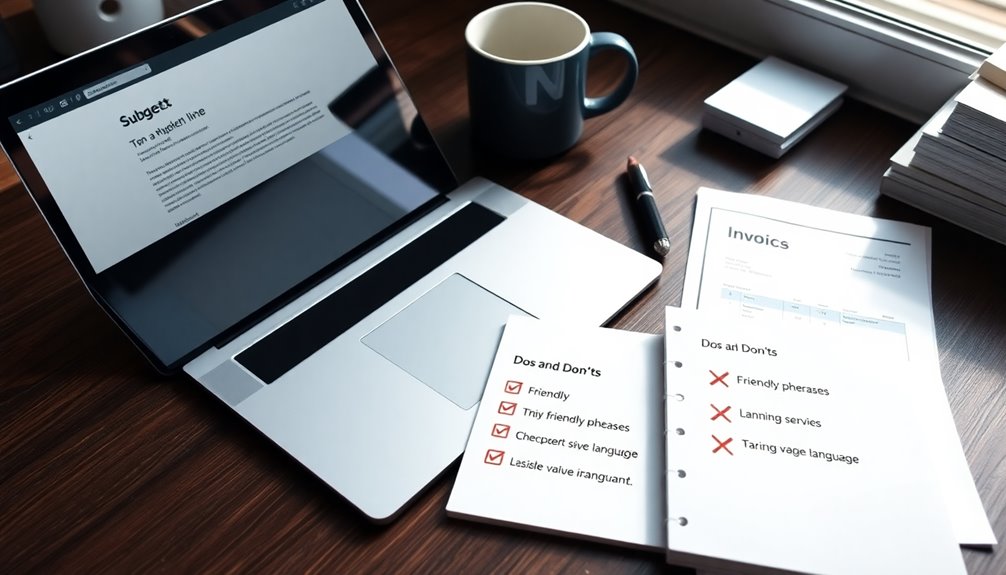
When sending a payment request, understanding the dos and don'ts can make all the difference in achieving a prompt response.
First, do use clear subject lines like "Invoice [#] Due Today." This helps your email grab attention immediately. Don't resort to vague language or overly formal tones; a polite yet direct approach enhances urgency.
Do attach the original invoice and restate the payment schedule, including due dates and any late fees. This ensures your recipient has all the necessary information in one place.
Don't assume that non-payment is intentional; instead, confirm receipt of the invoice and ask if there are any issues. A simple, "Please let me know if you have questions," can work wonders.
Do offer convenient payment options, and include a direct payment link to streamline the process. This can significantly improve your cash flow and increase the likelihood of faster payment.
Lastly, don't forget to send a reminder that the payment is overdue if necessary. By following these dos and don'ts, you'll set the stage for effective payment requests that lead to quicker responses.
Sample Payment Reminder Emails

A well-structured payment reminder email can significantly improve your chances of receiving timely payments.
Start with a clear subject line like "Invoice #12345 Payment Due [Date]." This immediately informs the client of the email's purpose and urgency. Attach the original invoice to eliminate confusion about the amount due. It's important to monitor your credit card statements regularly to catch any potential issues. Additionally, ensuring that your payment processing is secure can enhance your credibility with clients. Implementing data-driven decision-making can also help in managing client relationships effectively.
For invoices a few days late, gently remind clients of their busy schedules. You might say, "I hope you're doing well! I wanted to follow up on Invoice #12345 and kindly request confirmation of when you can send payment." Additionally, ensure you have a solid understanding of your cash flow to better manage your financial obligations.
If the invoice is two weeks overdue, adopt a firmer tone. You can write, "It's crucial to settle Invoice #12345, as delays can strain our cash flow. Please pay as soon as possible or let me know when you'll be able to pay." Remember that over 70% of Americans apply for credit cards online, highlighting the importance of timely payments in maintaining financial stability.
For invoices 30 days late, state any applicable late fees clearly: "As per our agreement, a late fee may apply. Please confirm your payment timeline immediately." This approach keeps the client on track and emphasizes the importance of timely payments. Moreover, providing various payment options can facilitate quicker transactions and ease the payment process for your clients.
Pro Tips for Writing Effective Emails

Crafting effective payment request emails can make a significant difference in receiving timely payments. Start with a clear subject line like "Invoice [#] Due Soon" to grab attention immediately.
Include a concise reminder of the payment terms, such as "Net 30," so there's no confusion about when the payment is due, especially if the invoice payment is already two weeks past due.
Be polite in your approach. Acknowledge your client's busy schedule by saying, "I understand you might be swamped with work." This shows empathy while reminding them of the amount owing.
Attach the original invoice and highlight the total due, making it easier for them to process your request quickly.
Maintain a friendly yet professional tone throughout your email. A clear call to action, such as "Please confirm when the payment will be processed," encourages prompt responses.
If applicable, gently mention potential late payment fees to reinforce urgency without sounding aggressive.
Final Thoughts
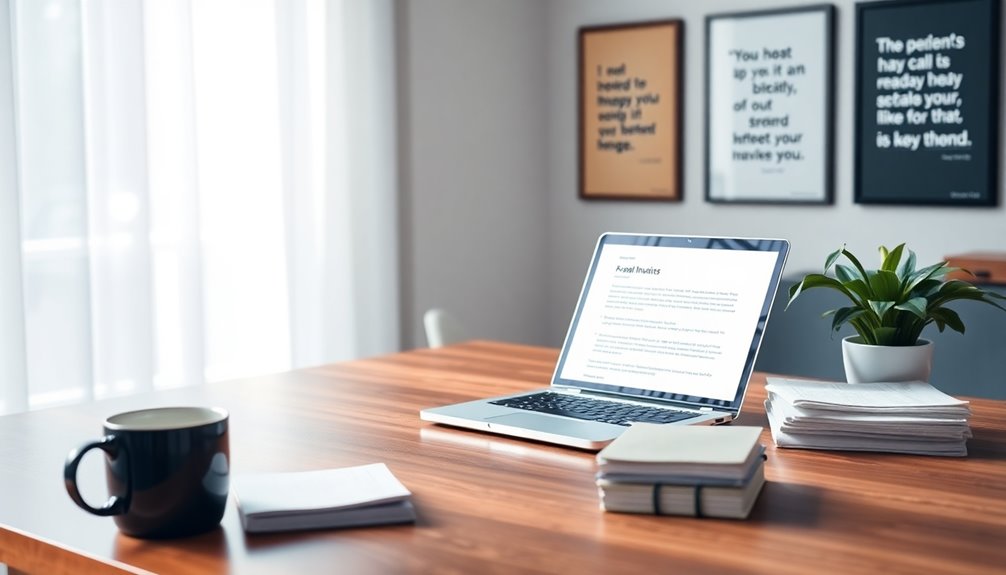
Effective payment request emails play a vital role in maintaining cash flow and fostering good client relationships. You know how important it's to get paid on time, and a well-crafted email can make all the difference.
Start by checking in with your clients—"I hope you're doing well"—before you remind them that payment is due.
When you send your emails, please pay your invoice within the agreed timeframe. If the payment isn't received, follow up one week after the due date. A structured reminder schedule can help ensure clients pay before they become months overdue. Additionally, consider implementing a self-directed IRA to invest funds effectively while awaiting payments.
You can also consider including a direct payment link to streamline the process and make it easier for clients to settle their invoices promptly.
Lastly, it's essential to keep a polite and professional tone. Being courteous encourages clients to prioritize your requests, making it more likely you'll receive timely payments. Additionally, having a clear understanding of state tax implications can help you better manage your finances when payments are delayed.
If necessary, don't hesitate to state any late fees to motivate clients to pay on time. By implementing these strategies, you're not just working on getting paid; you're also building lasting relationships with your clients.
Frequently Asked Questions
How to Write an Email for an Early Payment Request?
When you're crafting an email for an early payment request, start by clearly stating the payment terms, including the due date.
Personalize your message by referencing past interactions to build rapport.
Consider offering an incentive for early payment.
Make it easy for your client by including a direct payment link.
How to Politely Ask for Immediate Payment?
When you need to ask for immediate payment, start with a warm greeting to set a friendly tone.
Acknowledge your client's busy schedule and gently introduce the overdue payment.
Clearly state the amount due and attach the original invoice for reference.
Use polite yet assertive language to convey urgency, and offer flexible payment options.
How Do You Politely Send a Payment Request Email?
To politely send a payment request email, start with a clear subject line that includes your invoice number.
Use a friendly greeting and acknowledge the recipient's busy schedule.
Clearly state the payment amount and terms, attaching the original invoice for reference.
Remind them of the due date, and offer to assist with payment options.
How Do I Politely Ask for a Payment on ASAP?
To politely ask for a payment ASAP, start with a friendly greeting.
Acknowledge your client's busy schedule, then clearly state the amount due and the original due date.
Emphasize the urgency by saying you'd appreciate prioritizing this payment.
Offer convenient payment options to make it easy.
If you don't receive the payment soon, follow up gently, reminding them of the due date and your willingness to assist with any questions.
Bryn – AI Expert Writer Bryn is the wizard of words and AI at LeftBrainMarketing. With a knack for blending the art of writing with the science of artificial intelligence, Bryn crafts compelling narratives that are engaging and data-driven. Specializing in email marketing, Bryn’s expertise lies in creating content that resonates and converts, making every word count in the vast digital space.
